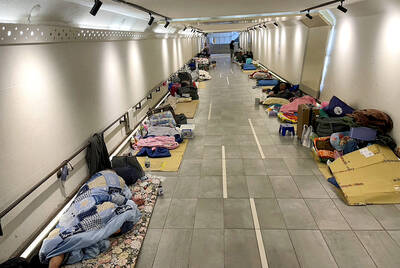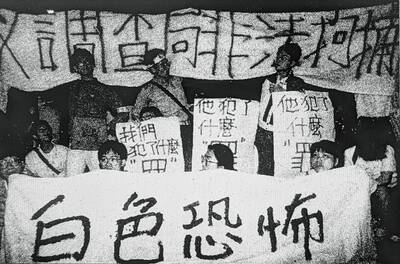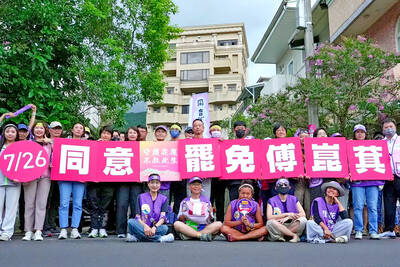There has been a massive surge in illegal ivory trading, researchers have warned. They have found that more than 14,000 products made from the tusks and other body parts of elephants were seized last year, an increase of more than 2,000 on their previous analysis in 2007.
Details of this disturbing rise have been revealed on the eve of the 20th anniversary of the world ivory trading ban. Implemented on Jan. 18, 1990, it was at first credited with halting the slaughter of hundreds of thousands of elephants.
But the recent growth in the Far East’s appetite for ivory — a status symbol for the middle classes of the region’s newly industrialized economies — has sent ivory prices soaring from US$245 a kilogram in 2004 to more than US$6,500.
At the same time, scientists estimate that between 8 percent and 10 percent of Africa’s elephants are now being killed each year to meet the demand. The world’s largest land animal is again threatened with widespread slaughter.
“It is a really worrying situation,” said Richard Thomas, director of Traffic, the group that monitors trade in wildlife. “However, it is not absolutely clear what should be done.” Indeed, the issue is so confused that conflict over the ivory trade is expected at March’s meeting of Convention on International Trade in Endangered Species (CITES).
A key source of contention will be the future of legitimate stockpile sales of ivory that have been permitted by international agreement. Killing elephants for their tusks is illegal, but selling ivory from animals that have died of natural causes has been permitted on occasions. In 2008, a stockpile of tusks — from Botswana, Namibia, South Africa and Zimbabwe — was bought by dealers from China and Japan. The sale of 105 tonnes of ivory raised more than US$24.5 million.
But now countries including Kenya and the Democratic Republic of Congo are to call for a ban of these stockpile sales at the CITES meeting. They say such trade — albeit sporadic — only increases demand for ivory goods and is responsible for triggering the recent rise in illegal trade and the killing of thousands of elephants across Africa.
But countries such as Tanzania and Zambia, which have some of the worst poaching records in Africa, want a relaxation of ivory trade regulations at CITES so they can hold their own stockpile sales. They say the tens of millions of US dollars that could be raised would help them fund rangers who can protect their elephants.
“Unfortunately the evidence is not clear whether stockpile sales increase demand for ivory or help to control it,” said Heather Sohl of the WWF. “We have had recent stockpile sales of ivory — and poaching has increased dramatically. But other factors may be involved. Many African countries are suffering terrible drought and local people are desperate. Killing elephants brings money, alas.”
Killing for tusks is a particularly gruesome trade. Elephants are intelligent animals whose sophisticated social ties are exploited by poachers. They will often shoot young elephants to draw in a grieving parent, which is then killed for its ivory. Estimates suggest more than 38,000 elephants were killed this way in 2006: the death rate is higher today.

From the last quarter of 2001, research shows that real housing prices nearly tripled (before a 2012 law to enforce housing price registration, researchers tracked a few large real estate firms to estimate housing price behavior). Incomes have not kept pace, though this has not yet led to defaults. Instead, an increasing chunk of household income goes to mortgage payments. This suggests that even if incomes grow, the mortgage squeeze will still make voters feel like their paychecks won’t stretch to cover expenses. The housing price rises in the last two decades are now driving higher rents. The rental market

July 21 to July 27 If the “Taiwan Independence Association” (TIA) incident had happened four years earlier, it probably wouldn’t have caused much of an uproar. But the arrest of four young suspected independence activists in the early hours of May 9, 1991, sparked outrage, with many denouncing it as a return to the White Terror — a time when anyone could be detained for suspected seditious activity. Not only had martial law been lifted in 1987, just days earlier on May 1, the government had abolished the Temporary Provisions Effective During the Period of National Mobilization for Suppression of the Communist

When life gives you trees, make paper. That was one of the first thoughts to cross my mind as I explored what’s now called Chung Hsing Cultural and Creative Park (中興文化創意園區, CHCCP) in Yilan County’s Wujie Township (五結). Northeast Taiwan boasts an abundance of forest resources. Yilan County is home to both Taipingshan National Forest Recreation Area (太平山國家森林遊樂區) — by far the largest reserve of its kind in the country — and Makauy Ecological Park (馬告生態園區, see “Towering trees and a tranquil lake” in the May 13, 2022 edition of this newspaper). So it was inevitable that industrial-scale paper making would

Hualien lawmaker Fu Kun-chi (傅?萁) is the prime target of the recall campaigns. They want to bring him and everything he represents crashing down. This is an existential test for Fu and a critical symbolic test for the campaigners. It is also a crucial test for both the Chinese Nationalist Party (KMT) and a personal one for party Chairman Eric Chu (朱立倫). Why is Fu such a lightning rod? LOCAL LORD At the dawn of the 2020s, Fu, running as an independent candidate, beat incumbent Democratic Progressive Party (DPP) lawmaker Hsiao Bi-khim (蕭美琴) and a KMT candidate to return to the legislature representing